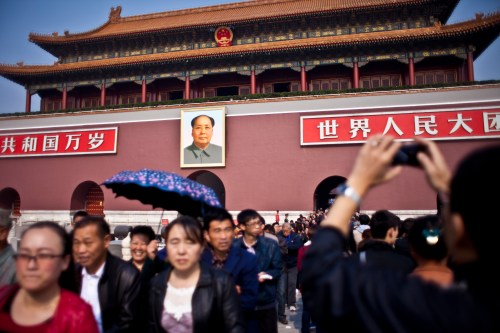When I was in Beijing earlier this month I became fascinated by the tourists flowing in and out of Tiananmen Gate, or capturing snapshots of each other with Mao’s portrait in the background, a great ideological Grand Canyon, the vacationer’s proof of purchase.
I wrote about it, but I did not mention how I’d crossed the Jinshui Bridge, above the ancient moat, and entered the Forbidden City myself. On the way, I captured this image of the crowd, a jumble of looks and expressions out of Ezra Pound’s faces in the Paris metro.
Yesterday, very near to where I snapped the shutter, a Jeep jumped the curb and crashed into the gate here, plowing through people, injuring dozens and killing five. Three of the dead were in the vehicle, which was almost certainly aimed into the crowds before it exploded into flame, a suicide attack.
The Chinese aren’t saying much, but foreign news reports, quoting anonymous sources close to the investigation, suggest that the incident may be linked to a separatist movement in Xinjiang, a province in China’s deep west. This Reuters story is particularly good.
The Economist, meanwhile, mentions a string of odd goings on that took place around the Forbidden City in the days prior to the blast. Reads a piece posted to the magazine’s site yesterday:
Just an hour before the crash, reports surfaced that a group of … seven or eight people caused a scene by linking arms and jumping fully clothed into a lake near the Forbidden City, the imperial palace that lies behind Tiananmen. Photos show the group huddled together, standing in the water.
It was also reported that on Friday October 25th a worker at the Forbidden City stabbed to death two of his co-workers, inside the palace’s cafeteria. Official media say the murders were the culmination of a dispute between employees.
The day I went, before I went across the bridge and through the gate, a friend of mine had told me that there is something sexual about visiting the Forbidden City: it is a series of revelations, one layer of intimacy wrapped in another, and at the centre you are in a private realm, an interloper, a voyeur.
Shortly after I’d passed through one of the many interior gates inside the palace, I stumbled across a group of people done up in finery and regalia. They were older, with sunned, wizened faces, and they wore dark turbans or towering headdresses, flowing robes encrusted with jewelry, floral cummerbunds and sneakers. I’ve included a shot of them here (if anyone can tell me how to get WordPress to publish this image as large as the one above, I’d be grateful).
I felt like I’d encountered characters from the One Thousand and One Nights. They did not appear to speak Mandarin, judging from the puzzled expressions on their faces when people approached them to take pictures. I assumed they were members of a minority ethnic group from a far-flung region of China, but they were so arresting a group that I also wondered if they were an official part of the pageant of the Forbidden City, like the green-tinted soldiers who march through the place—paid to wander the courtyards with their flashing teeth and high cheekbones.
But soon they were surrounded by tourists, a mob of vacationers clamoring for snapshots, and the members of the group began to turn their backs on the courtyard and huddle together, their smiles grown wooden.



